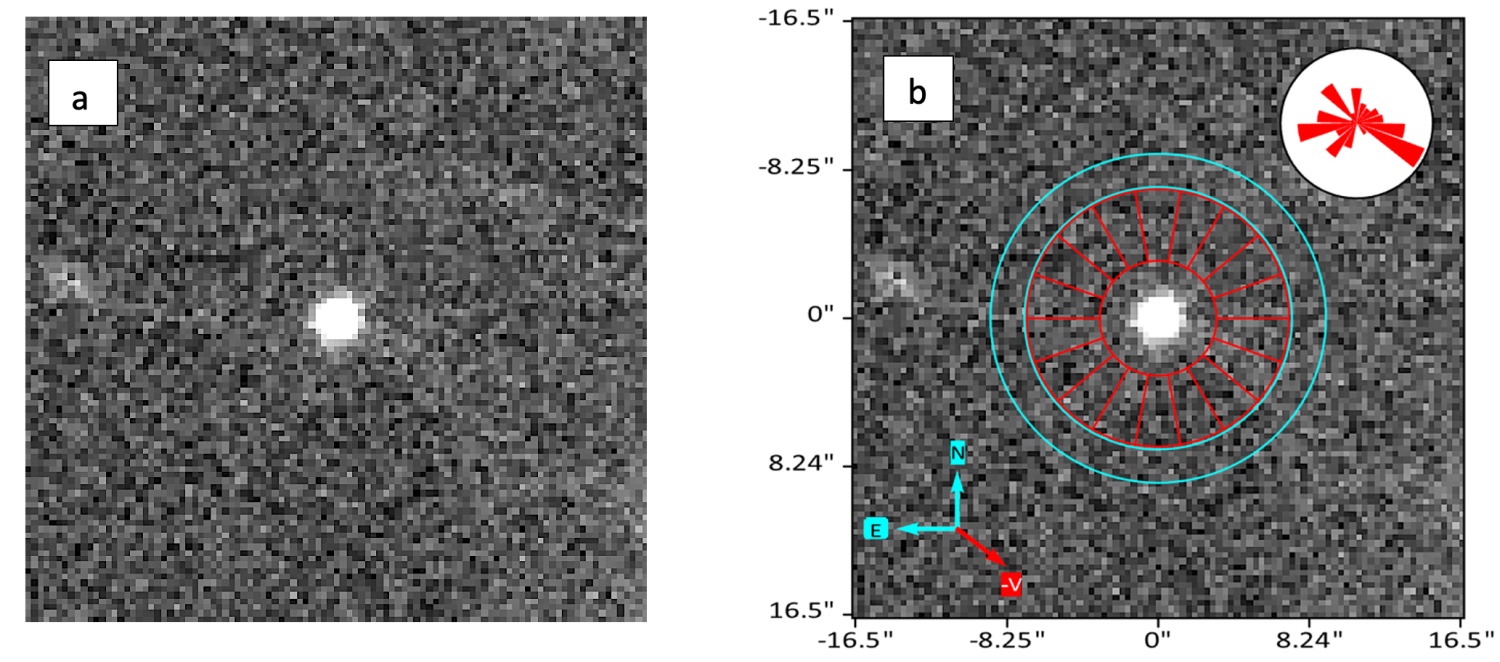A targeted search for Main Belt Comets
- Institute for Astronomy, University of Edinburgh, Royal Observatory, Edinburgh EH9 3HJ, UK
I - Introduction
Main Belt Comets (MBCs) display comet-like dust-release while occupying asteroid-like orbits in the Main Asteroid Belt (2AU<a<2.5AU). Asteroids and comets have long been perceived as two very distinct populations, initially formed within and beyond the snowline respectively, then split into separate reservoirs. However, the recent discovery of icy objects in the Main Belt, as well as of other active asteroids and inactive comets, blurs the physical, dynamical and observational boundaries between comets andasteroids and indicates it is rather a continuum.
So far no direct detection of gas has been made due to the low gas production rates in MBCs, but dust features of various strengths have been observed. Several mechanisms unrelated to outgassing can lead to apparent activity in asteroids, such as impacts or rotational instability. Therefore, to be recognised as an MBC, an active asteroid must display recurring activity (a tail and/or coma) during multiple passages at perihelion.
Sonnett et al. (2011) previously estimated the MBC to asteroid ratio to be <1:400 in the Main Belt. So far 8 objects have shown recurring activity, and sublimation is a possible driver of activity for a few more candidates (approximately 20 objects in total) (Jewitt & Hsieh 2022). Hence it is challenging to study and characterize such a small population.
Focusing on the Outer Main Belt (a>2.82AU) where most MBCs are found, Kim et al. (2018) showed that the longitudes of perihelion ϖ of MBCs and MBC candidates known at the time were clustered around that of Jupiter (ϖJ»15°). They concluded that, if this is a real feature of MBCs, these comets would more likely be discoverable in the northern fall night sky.
II - Methods
Using this hypothesis as a criterion, we conducted an imaging survey to search for new active asteroids and MBCs. We selected a sample of 530 Outer Main Belt asteroids with longitudes of perihelion 0°<ϖ<30, and the activity of which would likely be observable if they were MBCs (apparent magnitude, closeness to perihelion, etc.). These objects were observed between 2018 and 2020 using the Wide Field Camera on the Isaac Newton Telescope (La Palma, Spain) and a Sloan-r filter.
We developed an automated pipeline to reduce and analyse our data using tail and coma detection methods adapted from those developed by Sonnett et al. (2011). The tail detection method aims to detect an excess of brightness in one direction around the asteroid. An example is given in Figure 1. The coma detection method builds a frame-specific Point Spread Function (PSF) using neighbouring stars and an artificial coma-profile, then compares them to the asteroid to look for fuzziness. An example is given in Figure 2.
III – Results and perspectives
We reproduced the statistical study of Kim et al. (2018) taking into account more recent discoveries of active asteroids and MBCs (as summarised by Jewitt & Hsieh, 2022) and report that the clustering of longitudes of perihelion persists, which supports our approach a posteriori.
Out of our 549 observations (some asteroids having been observed multiple times), the pipeline was successfully applied to 291 asteroids that did not have any close neighbouring star biasing the analysis. For the remaining objects the pipeline performed the data reduction and produced deep images of the asteroids that we manually reviewed.
Among our targeted sample of objects, we report no detection of activity from the pipeline, nor from visual inspection of the remaining frames. For comparison, we applied the same procedure to random stars and random asteroids on our frames, and saw no difference in the distributions of activity detection levels. We will present our results and statistical conclusions on the MBC population. In the future, our research group intends to implement a similar pipeline to apply these methods to other data, in particular those from the Vera C. Rubin observatory.
Figures

Figure 1 - a: Asteroid 105073 observed on 10/11/2018. b: Illustration of the tail detection method developed by Sonnett et al. (2011). We compare the median brightness of each red segment to the local background flux (median in the cyan annulus). The top-right diagram represents the relative brightness of the segments. Here, the brightest segment is in the South-West direction. We then perform the same study on neighbouring stars to evaluate whether such brightness levels seem atypical given the quality of the frame. In this example, the asteroid happens to be crossing a background star. The star appears trailed as we stacked multiple exposures, giving it the aspect of a tail.

Figure 2 - Example of the coma detection method adapted from Sonnett et al. (2011), applied to asteroid 105073 observed on 10/11/2018. a: Thumbnail of the asteroid. b: PSF constructed from 12 neighbouring stars. c: Simulated coma profile built by convolving a 1/r profile with the PSF. We then fit a linear mix of the PSF and the coma profile to the image of the asteroid. In this case the best fit had a proportion of coma <10-4. d: Residue of the fit (image a subtracted to the best fit result).
Acknowledgements
We acknowledge contributions from Alan Fitzsimmons (Queen’s University, Belfast, UK) and Henry Hsieh (Planetary Science Institute, Honolulu, US), as well as observers Richard Smith (Queen’s University, Belfast, UK), Daniel Gardener (Institute for Astronomy, Edinburgh, UK) and Hissa Medeiros (Instituto de Astrofísica de Canarias, Tenerife, Spain).
References
David Jewitt and Henry H. Hsieh. The Asteroid-Comet Continuum. arXiv e-prints, arXiv:2203.01397, March 2022.
Yoonyoung Kim, Youngmin JeongAhn, and Henry H. Hsieh. Orbital Alignment of Main-belt Comets. 50:201.04D, October 2018.
Sarah Sonnett, Jan Kleyna, Robert Jedicke, and Joseph Masiero. Limits on the size and orbit distribution of main belt comets. Icarus, 215:534–546, October 2011.
How to cite: Ferellec, L., Snodgrass, C., and Opitom, C.: A targeted search for Main Belt Comets, Europlanet Science Congress 2022, Granada, Spain, 18–23 Sep 2022, EPSC2022-925, https://doi.org/10.5194/epsc2022-925, 2022.

